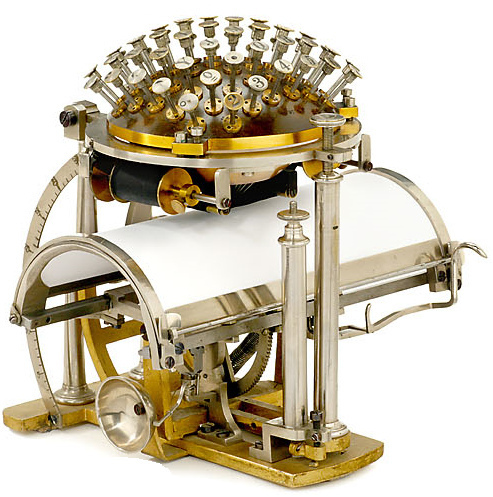User:Jeanine Verloop/graduationpaper
>>> graduation <<<
research paper
GRADUATION
>>> RESEARCH PAPER <<<
Jeanine Verloop
Major // illustration
USER PAGE JEANINE
Contents
- 1 Introduction
- 2 Question
- 3 Methodology
- 3.1 Introductory research activities
- 3.2 Desktop based
- 3.3 Practice based
- 3.4 Failed technology
- 3.5 The Malling-Hanson Writing Ball
- 3.6 Psychological impact of new technology
- 3.7 Remediation
- 3.8 Media archaeology
- 3.9 Key reference
- 3.10 Literature
- 3.11 Experiments
- 3.12 Robotics
- 3.13 POLOLU mini maestro servo controller
- 4 Results
- 5 Conclusion
Introduction
Forward
As a visual artist I am finding and exploiting the boundaries of a medium. I am always moving back and forth between different ways of telling a story, different ways of illustrating. For me illustration is telling a story or sharing information, by any medium possible.
You could say I am a remediation artist. I look back to the origins and implement that in my design and research. As some kind of archeologist I scavenge in 19th century inventions for inspirations. We must place the crafts in the contemporary landscapes by benefitting from techniques created in the digital revolution. Craft is not old and technology is not new.
You talk about craft, what would have been your craft if you lived back then?
I think I would live on some kind of junkyard, collecting all the strange curiosities of that age.
Introduction Graduation
My graduation project has it’s roots in earlier work, the printing devices. For me this project revolved around making, craft and fighting against the loss of knowledge. In the age of mass production I see less characteristics in our daily tools and objects, I wonder how this affects our imagination.
As Robert McLiam Wilson writes, in the introduction Wild at Heart for WilderMann, 'Plugged in, neurotically wi-fied and G3d as we are, we yearn to re-establish contact with the actual, the primal, the old. We dream of something real, something unmitigated by the filter of profit-making portals and franchises. We want the as-was, the erstwhile. We languish for the non-mechanical and the pre- or post-industrial. We are pilgrims seeking the past, the genuine, the individual.' I believe we will find this genuine and individual part in the act of making and producing.
What is the focus of this project?
As Laurie Anderson states ‘Technology is the campfire around which we tell stories’[1]. To tell new stories, the campfire has to evolve.
What is the value of doing this project nowadays? Why is this so special?
My work has close relation with technology and how we as a society mindlessly use our everyday products. Our products are more connected than ever and disconnected at the same time. We are rolling and scrolling without seeing something new. We are becoming one collective mind, the kind of mind that depends on screens for imagination. In my work, there is a pattern where I take complex everyday devices and remake them in hybrid artefacts.
When hand an machine fuse, magic happens. A machine produces reliable objects we expect to see. As a craftsman I enjoy the freedom to combine the tools of the digital revolution with the traditional tools of manufacturing. By combining I reveal a beauty that would have been impossible to conceive in the age of analogue alone.
Abstract
Image humanity through the eye of the alien, from space wouldn’t we look magical? From afar humans seem like a species that generates light, wherever humans are light follows. On closer inspection you would see that, disregarding its weak body, human kind dominates it habitat through the usage tools.
If you had been up there for a while you saw the shift. Humans began to build an industrialized civilization. The age of mass production dawned. For a time human kind flourished in their newly build utopia. Great tools were build. But when the utopia became the standard, humans became enslaved to automatisation. With no need for thinking, their brains got weaker, their ability to dream of radical new technologies faded.
Now humanity and tools live in disconnect, the magic is lost in utility. Humanity fails to be captivated by the technological landscape surrounding them. They have to find a way to re-insert themselves into a process where they are excluded from. Will they fantasize again when they are empowered to understand. When what is dead is resurrected?
Question
Our everyday devices, like printers, are lacking imagination in design and usage: How do I craft a fictional printer?
sub Q
Who are the losers in printing history?
When decomposed, what history can be found in our contemporary printers?
How does the device impact what the user will produce? How does technology influence the imagined result?
What is the psychological impact of new technology?
How does the printing surface relate to the printing mechanism?
When the machine produces, who owns the production?
Relevance of topic
The first caption in the book Digital handmade states ‘A renaissance in the art of making’ '. The industrial revolution created a new order. This period resulted in a diminishing role for the craftsman within a mechanized environment. But now, as before, industrial technologies are informing a new creative movement. Craftsman are resurfacing and benefitting from the precision, efficiency and increasingly unrestricted structural parameters of digital design and fabrication. While retaining the soul of the material and the skill of the human hand. William Morris wrote of the ‘craving for beauty’ awakening in the mind of men no longer tied to the production line. ‘exacting beauty, achieved only through the fusion of hand and machine, which presents a uniquely modern understanding and exploration of hand and machine, which presents a uniquely modern understanding and exploration of the relationship between designer and maker.’
‘Welcome or unwelcome, explicable of inexplicable, this prompt or pattern is undeniable real. Our dissatisfaction with our mental of spiritual diet is expressing itself despite us. It leaps out. Our imaginations are choking and constipated by the confections of Call of Duty 4 and Transformers 5. Our souls are crying out for the roughage of the primal.’ Robert McLiam Wilson, Wild at Heart, introduction WilderMann.
It has become clear to me that it is no coincidence that I am working on the lacking of imagination of our devices. I am not the only one. This is not a movement for art’s sakes, the large online DIY community makes that much clear.
Relevance to others
Hypothesis
My work will surprise and hopefully bring, for those who’ve seen it, a new meaning to printing.
Afbakening
Methodology
Introductory research activities
My first step was to formulate a short statement about my previous work. I did not wat to repeat myself and set the following criteria: If my realized work would become a functioning machine, the machine should be -semi- automated. My project should allow me to further develop my skills with electronics and robotics. With this statement in my mind I thought of the following possible threads. I used the visualization of a mind map to make in clearer.
DRAWING MACHINES.
GENERATIVE ART. Analog generating of patterns. If I choose to do this, the focus will be on the result (?).
GHOST MACHINES. Building new and alien mechanical systems from old machines. Revolves around the machine.
PRODUCTION LOOP. Building a machine that would have to be in a constant production loop to show result. (!) Intentionally I would be in the catagory: criticism on mass production. Is this something that I would want?
WORKSHOP. To use other people to make a collection / mix of old and new printing techniques.
FAILED TECHNOLOGY. Empower to understand new technologies by resurrecting what is "dead".
Desktop based
Born and raised in the digital age, most of my early research was conduction desktop based. I chose to start with researching failed technology. From there on I researched to following topics desktop based:
Failed technology: The Malling-Hanson Writing Ball
Psychological impact of new technology
Remediation
Media archeology
Practice based
My practice based research can be divided in Media Archeology and Prototyping.
Failed technology
My research in failed printing technology quickly led me to the development of typewriters, more specifically the development of the keyboard. Modern typewriters all have a very similar design, their invention was step-by-step process, developed by numerous inventor working mostly independently over a series of decades.
The Malling-Hanson Writing Ball
Psychological impact of new technology

Simon Pummel, Shock Head Soul How new technologies can contribute to obsession, triggers, delusion and fantasies.
Distrust is not something new, Peter Paul Verbeek describes how in the past people get afraid everytime technology takes a jump. "Die angst, gaat Verbeek verder, is kenmerkend voor perioden met veel en snelle technologische veranderingen. „Bij de industrialisering dacht men ook dat machines de mens zouden gaan vervangen.” ?"[2].
Remediation
How historical inventions are still present in our everyday objects. Weaving, computers, programming.
Media archaeology
Decompose contemporary machines and trace back to its origin. Look at the past, also at the present. Take them apart and the history will emerge.
To decompose:
Typewriter Olympia Traveller
Olympia portable typewriter traveller user guide [3]
Olympia portable typewriter traveller user guide [4] ENGLISH (!)
Panasonic KX-P1081
Panasonic KX-P1081 user manual [5]
Brother M-1324
Brother M-1324 Dot Matrix Printer Owner's Manual [6]
Brother DCP 4020C all in one
Brother DCP 4020C all in one user manual [7]
Key reference
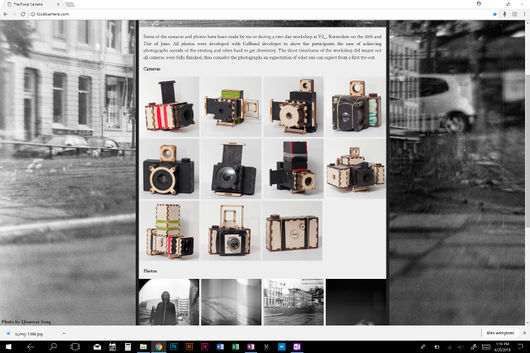 Mathijs van Oosterhoudt, The Focal Camara "The Focal Camera aims to take a critical look at how cameras are constructed and how design choices influence not only our usage of them, but also the photos they create.
Mathijs van Oosterhoudt, The Focal Camara "The Focal Camera aims to take a critical look at how cameras are constructed and how design choices influence not only our usage of them, but also the photos they create.
While many people own a camera or have the option to buy one, the choices made by commercial camera companies might not always be ones we would want or desire. Such companies first and foremost exist to create profit; in a way creating a capitalistic camera, one first and foremost to be sold, not used." [8]
Literature
Experiments
Robotics
I started working on a mechanical hand, to better my understanding of gears. I used this example [9] from instructables to make my first hand. I quickly found the movement of the fingers interesting.
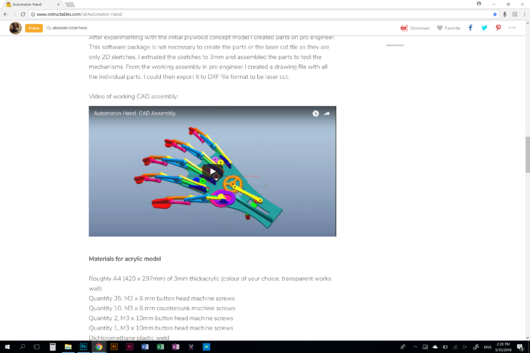
I used the robotic hand I made from instructables as a basis for further development. I set the goal, in the beginning of graduation, to work more with arduino. Not extremely complex stuff, but use some basic elements. I achieved a level of automation by using the little servo sg90 (specs)[10] motor.
[watch the process video here on vimeo]
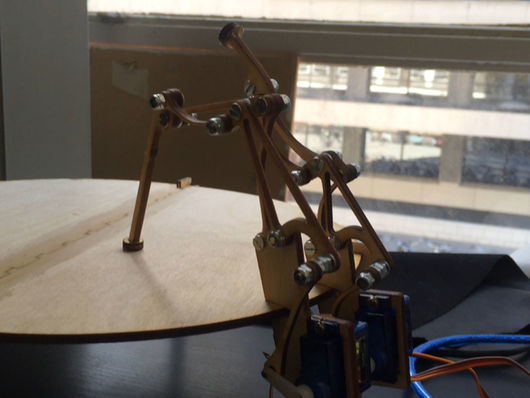
POLOLU mini maestro servo controller
Servos need a lot of current because they are required to change position from standstill while under load. So if a lot of torque is need to move the output shaft, more torque = more current. If the servo has to hold a fixed position and is still under a load torque, the servo will continue to draw significant current to hold that position. With 3 servos attached the Arduino already did not have enough power.
I fixed this problem with the Pololu mini maestro micro controllers [11]
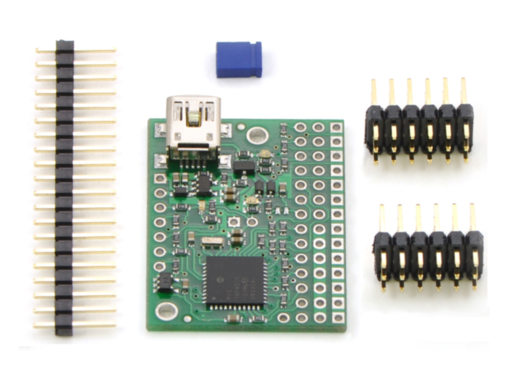
Results
Insights from experimentation
Artistic / Design principles
Artistic / Desing Proposal
Conclusion
Realised work
Stand alone presentation
What was the point? What do I take away?
- ↑ Technology is the campfire around which we tell our stories, Laurie Anderson link
- ↑ Peter-Paul Verbeek, Wij hebben geen klauwen en dus hebben we ’n iPhone, website
- ↑ Olympia portable typewriter traveller user guide link
- ↑ Olympia portable typewriter traveller user guide link
- ↑ Panasonic KX-P1081 user manual link
- ↑ Brother M-1324 Dot Matrix Printer Owner's Manual link
- ↑ Brother DCP4020C all in one user manual link
- ↑ The Focal Camara, Mathijs Oosterhoudt link
- ↑ Example mechanical hand link
- ↑ servo sg90 motor specs link
- ↑ Pololu mini maestro link
